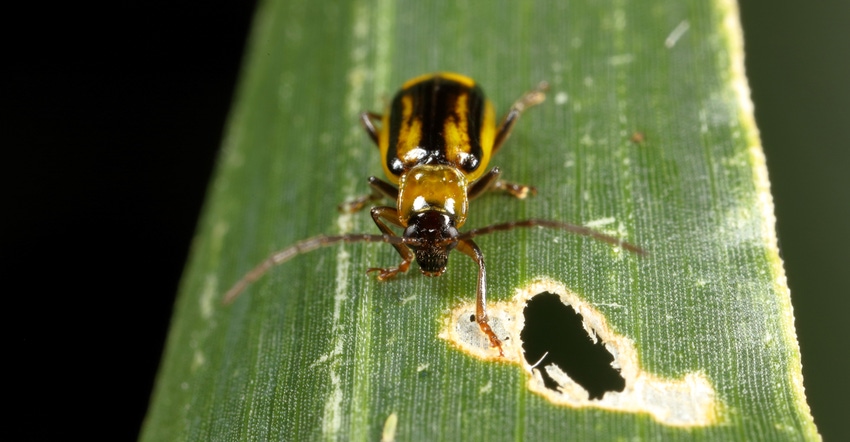
While most insect pressure was tame in Illinois in 2020, corn rootworms were a standout problem, according to the annual Illinois Cooperative Agricultural Pest Survey.
Survey coordinator Kelly Estes sees both higher populations and evidence of growing resistance to Bt hybrids.
Related: Checking in on corn rootworm
Rootworm resistance to Bt corn is nothing new. In recent years, however, the problem has been mostly invisible to growers because rainy springs mean fewer rootworm larvae survive to prune root nodes and resist Bt traits. If and when Illinois has drier spring conditions, Estes says growers will be dealing with a harder-to-manage pest.
“That’s why it’s important they take steps to manage resistance now,” says University of Illinois entomologist Nick Seiter.
Related: Can you skip the rootworm trait this year?
He received more reports of western and northern corn rootworm beetles in northwestern Illinois than in any other region in 2020. That’s to be expected, due to more continuous corn acreage in the region. It’s led to the area trending toward higher rootworm populations since 2015.
“We’re getting reports of more feeding on Bt corn there,” Seiter says, adding farmers should consider rotating to non-Bt corn and using a soil insecticide as a tactic to combat resistance. Doing so now when insect pressure is low will add more shelf life to Bt traits, helping to slow the pace of resistance to the four commercially available traits.
Rotation-resistant populations of western corn rootworm in Illinois lay their eggs in soybeans and neighboring fields, where they survive for the next corn season. Also, the eggs of some northern corn rootworm populations in the U.S. can hibernate in the soil for two or more winters. Despite this resistance to crop rotation, it’s still a tactic that reduces rootworm density and takes pressure off Bt traits, thus decreasing selection pressure for Bt-resistant rootworm.
Relying on a Bt trait alone means there’s only one resistance gap for the infamously adaptable corn rootworm to cross in a given field. That’s why products such as Intrasect Xtreme, AcreMax Xtreme, SmartStax, Qrome and Agrisure 3122 pyramid multiple Bt traits in the same hybrid. The moderate doses of toxic proteins help protect root systems against damaging levels of injury. But scientists have documented resistance to the Cry3Bb1, mCry3A and eCry3.1Ab toxins in Illinois and the rest of the Corn Belt for a decade now, Seiter says.
The remaining Bt trait, Cry34/35Ab1, is the underpinning of most Bt corn hybrids planted in 2020. Corteva Agriscience found populations resistant to the trait in a continuous corn region in Iowa a few years ago. While scientists haven’t confirmed widespread resistance to the trait in Illinois, field and laboratory data shows it’s becoming less effective here.
U of I research shows that 70% of western corn rootworm from some populations in DeKalb County, Ill., survive the Cry34/35Ab1 toxin, while 90% survive against Cry3 toxins.
How to combat rootworm resistance
U of I Prairie Research Institute entomologist Joseph Spencer has spent the last decade encouraging farmers in the Champaign County, Ill., area to reduce their use of Bt corn hybrids against corn rootworm.
He saw use of rootworm-targeting Bt corn hybrids peak at about 75% of hybrids planted in the area — now it’s down to about 50%. He encourages farmers to use a Bt trait only if there’s likely to be an economically damaging population in their fields, as can often be the case on continuous corn farmland. When scouting for beetles, the economic threshold is two rootworm beetles per trap per day in corn following corn. It’s one and a half beetles in soybeans going to corn in 2021.
“We need to protect the remaining efficacy of the Bt traits that we still have,” Spencer says. He notes that using Bt hybrids only when an economically damaging population of rootworm is likely will reduce selection for resistance in the rootworm population.
RNA interference technology is due to be commercially available in a few years. The technology pyramids a new mode of action with existing Bt traits, underscoring the need to limit the use of Bt hybrids so the underlying traits are still effective when RNA interference becomes available.
“Once these products are on the market, this will be the first new mode of action deployed against corn rootworm beetles since Cry34/35Ab1 was commercialized in 2006,” Spencer says.
He recommends using Bt hybrids as one component in a larger strategy that involves rotation to soybeans and non-Bt corn. In areas plagued by the western corn rootworm variant, a soil-applied insecticide on non-Bt corn can provide extra protection for a population reduced by a preceding soybean year. Spencer recommends using a pyramided hybrid in the second year of corn, but not to use a soil insecticide in the same year, as using both strategies at the same time doesn’t help to manage resistance.
Doing nothing to combat small populations of corn rootworm is also an option. It comes with the monetary reward of not paying a premium and the pest management reward of putting less selection pressure on a field’s corn rootworm population.
“When field-specific monitoring indicates that rootworm populations will be below economically damaging levels, forgoing rootworm control helps to prevent needless selection of Bt-resistance,” Spencer says.
He concludes that farmers who impede the development resistance on their fields aren’t just preserving their current options. “It will help to prolong and reinforce the efficacy of new products as well,” he says.
About the Author(s)
You May Also Like




